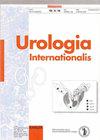The clinical symptoms and psychological status of biofeedback electrical stimulation combined with pelvic floor muscle training during the treatment of mild stress urinary incontinence after holmium laser enucleation of the prostate.
IF 1.5
4区 医学
Q3 UROLOGY & NEPHROLOGY
引用次数: 0
Abstract
Introduction:To study the clinical symptoms and psychological status of biofeedback electrical stimulation combined with pelvic floor muscle training during the treatment of mild stress urinary incontinence (SUI) after holmium laser enucleation of the prostate (HoLEP). Methods:Group A was treated by biofeedback and electrical stimulation; Group B was treated by pelvic floor muscle training; and Group C was treated by biofeedback and electrical stimulation combined with pelvic floor muscle training. Patients in the 3 groups had follow-up evaluations every 8, 16, and 24 weeks. Clinical symptoms of urinary incontinence were assessed using the 24-hour urinary pad test, the Incontinence Questionnaire-Urinary Incontinence Short Form (ICIQ-UI-SF); and psychological status was evaluated using the modified Hospital Anxiety Depression Scale (HADS). Results:The results of ICIQ-UI-SF showed that there were differences within and between the three groups at 8 weeks, 16 weeks, and 24 weeks (P<0.05). The results of the 24-hour pad tests were similar (P<0.05), except for no difference between Group B and Group C at 8 weeks(P>0.05). In the study with the score of HADS > 35, the differences among the three groups were statistically significant(P<0.05). There was no significant difference among the three groups at 0 and 8 weeks (P>0.05). There were differences in the results between Group C and the other two groups at 16 and 24 weeks of treatment (P<0.05) .For patients with HADS < 35 at week 0, the results were basically the same except for the difference between groups at week 8. HADS of all patients were no statistical difference (P > 0.05). Conclusions:Biofeedback electrical stimulation combined with pelvic floor muscle training is an efficient non-surgical combination therapy for the symptoms of SUI after HoLEP for BPH. In addition, the recovery of the patient's psychological state does not coincide with the recovery of urinary incontinence; therefore, we propose that patients still need additional psychological treatment after SUI disappears.生物反馈电刺激结合盆底肌肉训练治疗前列腺钬激光去核术后轻度压力性尿失禁的临床症状和心理状态。
摘要:目的:研究生物反馈电刺激联合盆底肌肉训练治疗前列腺钬激光去核术(HoLEP)后轻度压力性尿失禁(SUI)的临床症状和心理状态。方法:A组采用生物反馈和电刺激治疗;B组采用盆底肌肉训练治疗;C组采用生物反馈和电刺激结合盆底肌肉训练治疗。三组患者每 8 周、16 周和 24 周接受一次随访评估。采用24小时尿垫测试、尿失禁问卷-尿失禁简表(ICIQ-UI-SF)评估尿失禁的临床症状;采用改良的医院焦虑抑郁量表(HADS)评估心理状态。结果:ICIQ-UI-SF的结果显示,8周、16周和24周时三组内和三组间存在差异(P<0.05)。除 B 组与 C 组在 8 周时无差异(P>0.05)外,24 小时垫测试结果相似(P<0.05)。在 HADS 35 分的研究中,三组之间的差异有统计学意义(P<0.05)。在 0 周和 8 周时,三组间差异无统计学意义(P>0.05)。治疗 16 周和 24 周时,C 组与其他两组的结果存在差异(P<0.05)。对于第 0 周时 HADS 为 35 的患者,除第 8 周时组间存在差异外,其他结果基本相同。所有患者的 HADS 均无统计学差异(P> 0.05)。结论:生物反馈电刺激联合盆底肌肉训练是治疗前列腺增生症(HoLEP)术后 SUI 症状的一种有效的非手术综合疗法。此外,患者心理状态的恢复与尿失禁的恢复并不一致;因此,我们建议患者在 SUI 消失后仍需要额外的心理治疗。
本文章由计算机程序翻译,如有差异,请以英文原文为准。
求助全文
约1分钟内获得全文
求助全文
来源期刊

Urologia Internationalis
医学-泌尿学与肾脏学
CiteScore
3.30
自引率
6.20%
发文量
94
审稿时长
3-8 weeks
期刊介绍:
Concise but fully substantiated international reports of clinically oriented research into science and current management of urogenital disorders form the nucleus of original as well as basic research papers. These are supplemented by up-to-date reviews by international experts on the state-of-the-art of key topics of clinical urological practice. Essential topics receiving regular coverage include the introduction of new techniques and instrumentation as well as the evaluation of new functional tests and diagnostic methods. Special attention is given to advances in surgical techniques and clinical oncology. The regular publication of selected case reports represents the great variation in urological disease and illustrates treatment solutions in singular cases.
 求助内容:
求助内容: 应助结果提醒方式:
应助结果提醒方式:


